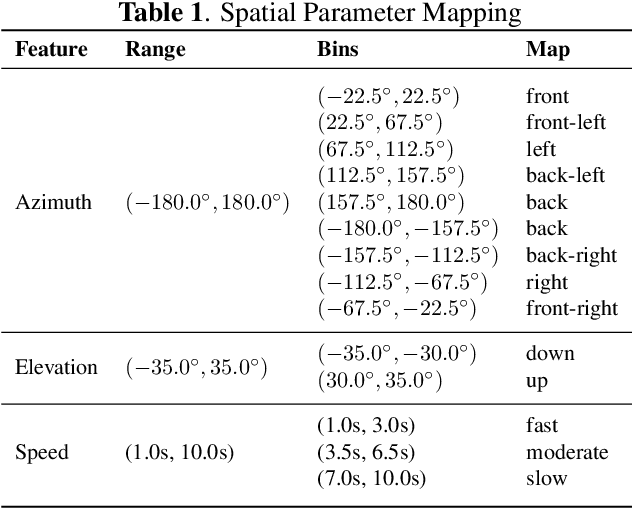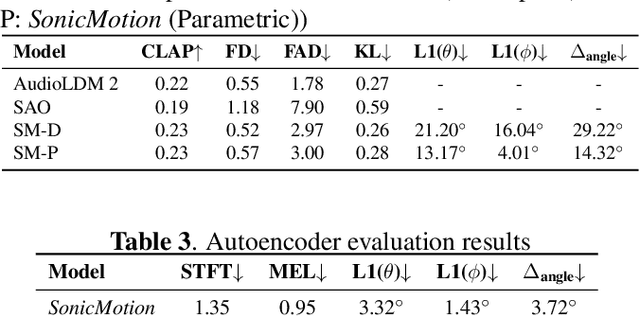music generation
Music generation is the task of generating music or music-like sounds from a model or algorithm.
Papers and Code
MixAssist: An Audio-Language Dataset for Co-Creative AI Assistance in Music Mixing
Jul 08, 2025While AI presents significant potential for enhancing music mixing and mastering workflows, current research predominantly emphasizes end-to-end automation or generation, often overlooking the collaborative and instructional dimensions vital for co-creative processes. This gap leaves artists, particularly amateurs seeking to develop expertise, underserved. To bridge this, we introduce MixAssist, a novel audio-language dataset capturing the situated, multi-turn dialogue between expert and amateur music producers during collaborative mixing sessions. Comprising 431 audio-grounded conversational turns derived from 7 in-depth sessions involving 12 producers, MixAssist provides a unique resource for training and evaluating audio-language models that can comprehend and respond to the complexities of real-world music production dialogues. Our evaluations, including automated LLM-as-a-judge assessments and human expert comparisons, demonstrate that fine-tuning models such as Qwen-Audio on MixAssist can yield promising results, with Qwen significantly outperforming other tested models in generating helpful, contextually relevant mixing advice. By focusing on co-creative instruction grounded in audio context, MixAssist enables the development of intelligent AI assistants designed to support and augment the creative process in music mixing.
SonicVerse: Multi-Task Learning for Music Feature-Informed Captioning
Jun 18, 2025Detailed captions that accurately reflect the characteristics of a music piece can enrich music databases and drive forward research in music AI. This paper introduces a multi-task music captioning model, SonicVerse, that integrates caption generation with auxiliary music feature detection tasks such as key detection, vocals detection, and more, so as to directly capture both low-level acoustic details as well as high-level musical attributes. The key contribution is a projection-based architecture that transforms audio input into language tokens, while simultaneously detecting music features through dedicated auxiliary heads. The outputs of these heads are also projected into language tokens, to enhance the captioning input. This framework not only produces rich, descriptive captions for short music fragments but also directly enables the generation of detailed time-informed descriptions for longer music pieces, by chaining the outputs using a large-language model. To train the model, we extended the MusicBench dataset by annotating it with music features using MIRFLEX, a modular music feature extractor, resulting in paired audio, captions and music feature data. Experimental results show that incorporating features in this way improves the quality and detail of the generated captions.
* 14 pages, 2 figures, Accepted to AIMC 2025
MGE-LDM: Joint Latent Diffusion for Simultaneous Music Generation and Source Extraction
May 29, 2025



We present MGE-LDM, a unified latent diffusion framework for simultaneous music generation, source imputation, and query-driven source separation. Unlike prior approaches constrained to fixed instrument classes, MGE-LDM learns a joint distribution over full mixtures, submixtures, and individual stems within a single compact latent diffusion model. At inference, MGE-LDM enables (1) complete mixture generation, (2) partial generation (i.e., source imputation), and (3) text-conditioned extraction of arbitrary sources. By formulating both separation and imputation as conditional inpainting tasks in the latent space, our approach supports flexible, class-agnostic manipulation of arbitrary instrument sources. Notably, MGE-LDM can be trained jointly across heterogeneous multi-track datasets (e.g., Slakh2100, MUSDB18, MoisesDB) without relying on predefined instrument categories. Audio samples are available at our project page: https://yoongi43.github.io/MGELDM_Samples/.
Text2midi-InferAlign: Improving Symbolic Music Generation with Inference-Time Alignment
May 19, 2025



We present Text2midi-InferAlign, a novel technique for improving symbolic music generation at inference time. Our method leverages text-to-audio alignment and music structural alignment rewards during inference to encourage the generated music to be consistent with the input caption. Specifically, we introduce two objectives scores: a text-audio consistency score that measures rhythmic alignment between the generated music and the original text caption, and a harmonic consistency score that penalizes generated music containing notes inconsistent with the key. By optimizing these alignment-based objectives during the generation process, our model produces symbolic music that is more closely tied to the input captions, thereby improving the overall quality and coherence of the generated compositions. Our approach can extend any existing autoregressive model without requiring further training or fine-tuning. We evaluate our work on top of Text2midi - an existing text-to-midi generation model, demonstrating significant improvements in both objective and subjective evaluation metrics.
Towards Video to Piano Music Generation with Chain-of-Perform Support Benchmarks
May 26, 2025

Generating high-quality piano audio from video requires precise synchronization between visual cues and musical output, ensuring accurate semantic and temporal alignment.However, existing evaluation datasets do not fully capture the intricate synchronization required for piano music generation. A comprehensive benchmark is essential for two primary reasons: (1) existing metrics fail to reflect the complexity of video-to-piano music interactions, and (2) a dedicated benchmark dataset can provide valuable insights to accelerate progress in high-quality piano music generation. To address these challenges, we introduce the CoP Benchmark Dataset-a fully open-sourced, multimodal benchmark designed specifically for video-guided piano music generation. The proposed Chain-of-Perform (CoP) benchmark offers several compelling features: (1) detailed multimodal annotations, enabling precise semantic and temporal alignment between video content and piano audio via step-by-step Chain-of-Perform guidance; (2) a versatile evaluation framework for rigorous assessment of both general-purpose and specialized video-to-piano generation tasks; and (3) full open-sourcing of the dataset, annotations, and evaluation protocols. The dataset is publicly available at https://github.com/acappemin/Video-to-Audio-and-Piano, with a continuously updated leaderboard to promote ongoing research in this domain.
Adaptive Accompaniment with ReaLchords
Jun 17, 2025Jamming requires coordination, anticipation, and collaborative creativity between musicians. Current generative models of music produce expressive output but are not able to generate in an \emph{online} manner, meaning simultaneously with other musicians (human or otherwise). We propose ReaLchords, an online generative model for improvising chord accompaniment to user melody. We start with an online model pretrained by maximum likelihood, and use reinforcement learning to finetune the model for online use. The finetuning objective leverages both a novel reward model that provides feedback on both harmonic and temporal coherency between melody and chord, and a divergence term that implements a novel type of distillation from a teacher model that can see the future melody. Through quantitative experiments and listening tests, we demonstrate that the resulting model adapts well to unfamiliar input and produce fitting accompaniment. ReaLchords opens the door to live jamming, as well as simultaneous co-creation in other modalities.
LEGATO: Large-scale End-to-end Generalizable Approach to Typeset OMR
Jun 23, 2025We propose Legato, a new end-to-end transformer model for optical music recognition (OMR). Legato is the first large-scale pretrained OMR model capable of recognizing full-page or multi-page typeset music scores and the first to generate documents in ABC notation, a concise, human-readable format for symbolic music. Bringing together a pretrained vision encoder with an ABC decoder trained on a dataset of more than 214K images, our model exhibits the strong ability to generalize across various typeset scores. We conduct experiments on a range of datasets and demonstrate that our model achieves state-of-the-art performance. Given the lack of a standardized evaluation for end-to-end OMR, we comprehensively compare our model against the previous state of the art using a diverse set of metrics.
OpenDance: Multimodal Controllable 3D Dance Generation Using Large-scale Internet Data
Jun 09, 2025Music-driven dance generation offers significant creative potential yet faces considerable challenges. The absence of fine-grained multimodal data and the difficulty of flexible multi-conditional generation limit previous works on generation controllability and diversity in practice. In this paper, we build OpenDance5D, an extensive human dance dataset comprising over 101 hours across 14 distinct genres. Each sample has five modalities to facilitate robust cross-modal learning: RGB video, audio, 2D keypoints, 3D motion, and fine-grained textual descriptions from human arts. Furthermore, we propose OpenDanceNet, a unified masked modeling framework for controllable dance generation conditioned on music and arbitrary combinations of text prompts, keypoints, or character positioning. Comprehensive experiments demonstrate that OpenDanceNet achieves high-fidelity and flexible controllability.
LeVo: High-Quality Song Generation with Multi-Preference Alignment
Jun 09, 2025Recent advances in large language models (LLMs) and audio language models have significantly improved music generation, particularly in lyrics-to-song generation. However, existing approaches still struggle with the complex composition of songs and the scarcity of high-quality data, leading to limitations in sound quality, musicality, instruction following, and vocal-instrument harmony. To address these challenges, we introduce LeVo, an LM-based framework consisting of LeLM and a music codec. LeLM is capable of parallelly modeling two types of tokens: mixed tokens, which represent the combined audio of vocals and accompaniment to achieve vocal-instrument harmony, and dual-track tokens, which separately encode vocals and accompaniment for high-quality song generation. It employs two decoder-only transformers and a modular extension training strategy to prevent interference between different token types. To further enhance musicality and instruction following, we introduce a multi-preference alignment method based on Direct Preference Optimization (DPO). This method handles diverse human preferences through a semi-automatic data construction process and DPO post-training. Experimental results demonstrate that LeVo consistently outperforms existing methods on both objective and subjective metrics. Ablation studies further justify the effectiveness of our designs. Audio examples are available at https://levo-demo.github.io/.
SonicMotion: Dynamic Spatial Audio Soundscapes with Latent Diffusion Models
Jul 09, 2025


Spatial audio is an integral part of immersive entertainment, such as VR/AR, and has seen increasing popularity in cinema and music as well. The most common format of spatial audio is described as first-order Ambisonics (FOA). We seek to extend recent advancements in FOA generative AI models to enable the generation of 3D scenes with dynamic sound sources. Our proposed end-to-end model, SonicMotion, comes in two variations which vary in their user input and level of precision in sound source localization. In addition to our model, we also present a new dataset of simulated spatial audio-caption pairs. Evaluation of our models demonstrate that they are capable of matching the semantic alignment and audio quality of state of the art models while capturing the desired spatial attributes.
 Add to Chrome
Add to Chrome Add to Firefox
Add to Firefox Add to Edge
Add to Edge